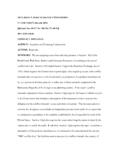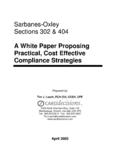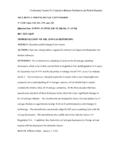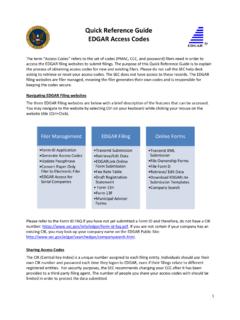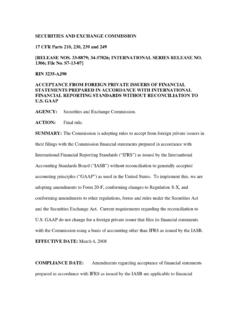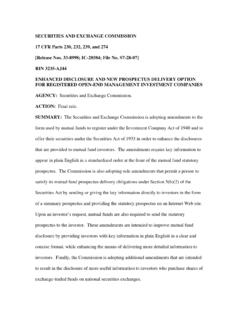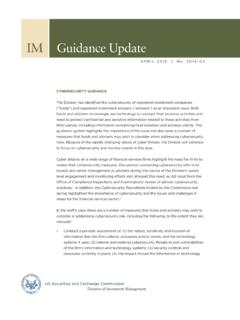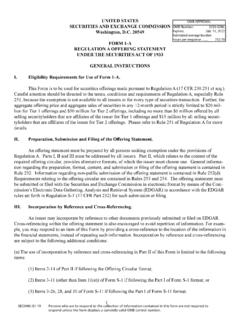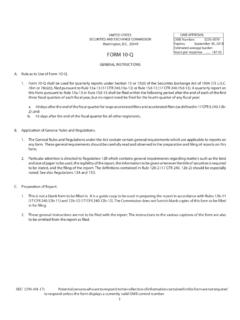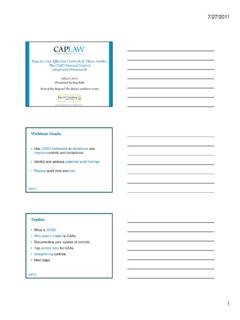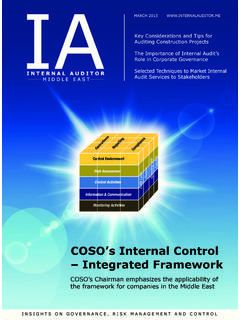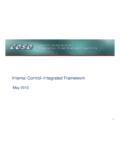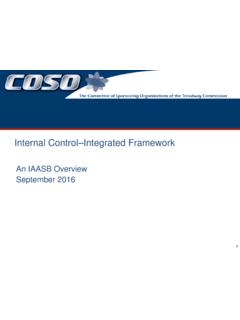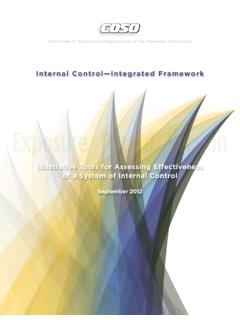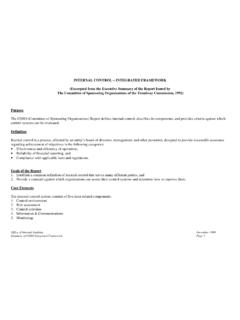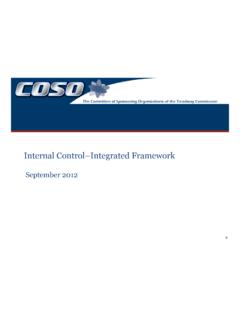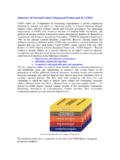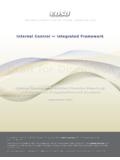Transcription of Internal Control – Integrated Framework COSO …
1 May 16, 2006 Reference File No. 4-511 Mr. Christopher Cox Mr. John White Chairman Director of the Division of Corporate Finance Securities & Exchange Commission Securities & Exchange Commission 100 F Street, NE 100 F Street, NE Washington, DC 20549 Washington, DC 20549 Dear Chairman Cox and Mr. White: During the SEC and PCAOB Roundtable on Internal Control Reporting and Auditing Provisions last week, a question was raised regarding the current project undertaken by coso . The purpose of this letter is to provide you with additional information with respect to the question raised.
2 In January of 2005, coso began a project to provide additional guidance in the application of its Internal Control Integrated Framework . This additional guidance is based on fundamental principles of Internal Control that were included in coso s original Framework ; principles which coso believes are applicable to all organizations. In October of 2005, an exposure draft of this guidance, coso Control Guidance for Smaller Businesses was published for public comment. Many comments and constructive suggestions were submitted in response to this exposure draft. After careful consideration of all the comments and revision of the exposure draft based on these comments, coso is finalizing the document and planning for publication, both in printed version and on our website by June 30.
3 In the process of considering the comments received during the exposure period, issues raised by the SEC s Advisory Committee on Smaller Public Companies were considered and addressed. I address the issues raised by that committee in an appendix to this letter. We do feel that the forthcoming guidance addresses the comments raised by the Advisory Committee. This new coso guidance will be published in three documents each designed for a specific purpose and audience. The volumes are: Executive Overview intended for all users, but especially management, CFO s, and boards. Small Business Guidance: Principles and Attributes of those principles.
4 This is hands-on guidance for each of the coso Internal Control components with examples of how small businesses are implementing effective Internal Control . Implementation Tools. These are tools that small businesses might utilize to organize information about Internal Control . Additionally, the guidance provides mechanisms for more efficient bases for Internal Control assessments than we have seen in the past two years. For example, the guidance points out that once a company establishes effective Internal Control the monitoring component of the Framework might be used for management s continued assessment of Control effectiveness.
5 We believe this guidance will be helpful to smaller organizations in establishing effective Internal Control over financial reporting. This guidance, while providing many useful tools and examples, does not provide a specific checklist for management to follow in order to evaluate its Internal Control . Rather, the guidance requires management to use informed judgment in establishing and evaluating its Internal Control , do the controls achieve the objective of providing reasonable assurance regarding the preparation of reliable financial statements. coso was established because the sponsoring organizations were concerned about fraudulent financial reporting.
6 Our recommendations contained in the National Report on Fraudulent Financial Reporting (1987) shows our commitment to improving transparent financial reporting and closely parallel the actions taken by Congress in the Sarbanes-Oxley Act. coso believes that all companies - public or private, large or small, US domiciled or foreign domiciled - should commit to implementing effective Internal controls to ensure that their financial statements are free from fraud or other material misstatement. The objectives oriented approach in the forthcoming guidance reiterates that simple proposition and provides guidance to achieve those objectives with management making cost-benefit decisions as to the appropriate set of controls to implement.
7 coso remains committed to working with all constituents, domestically and globally, to promote the achievement of effective Control and risk management across all organizations. To that end, the coso board has approved a strategic planning process that will begin immediately to explore more effective ways for coso to achieve its objectives, including input from the SEC and other constituent organizations. Sincerely, Larry E. Rittenberg Chair, coso Commissioner Paul S. Atkins Commissioner Roel C. Campos Commissioner Cynthia A. Glassman Commissioner Annette L. Nazareth Scott Taub, Acting Chief Accountant Willis D.
8 Gradison, Acting Chairman of the PCAOB Kayla J. Gillan, Member, PCAOB Daniel L. Goelzer, Member, PCAOB Charles D. Niemeier, Member, PCAOB Tom Ray, Chief Auditor, PCAOB Jennifer Burns, Office of the Chief Accountant Keith Wilson, PCAOB Staff coso Board Members: David Richards Charles Landes Mark Beasley Nick Cyprus Jeff Thomson PricewaterhouseCoopers Project Team: Miles Everson Frank Martens Mario Patone coso RESPONSE TO SEC ADVISORY COMMITTEE ON SMALLER PUBLIC COMPANIES May 16, 2006 The Advisory Committee issued its report on April 23, 2006. In that report, the Advisory Committee makes a number of statements, all in the same tone, and generally framed as: unless and until a Framework for assessing Internal Control over financial reporting for such companies [smaller businesses] is developed that recognizes their characteristics and needs (p.)
9 6). That statement is then followed by a series of recommendations supporting some relief for smaller public companies. The implication is that the coso Internal Control , Integrated Framework (the Framework ) does not recognize the characteristics and needs of such companies. We address the nature of the coso Framework in this appendix and further espouse the basis for our belief that the Framework is applicable to all businesses - large or small, public or non-public, domestic or foreign registered. We believe the recommendations made by the committee are issues that the Commission rightfully addresses and therefore we are silent on the merits of the recommendations other than stating that coso believes that fraudulent financial reporting is not the unique province of larger companies1.
10 Further, as stated in my letter, coso believes that all companies ought to commit to a system of Internal Control that provides reasonable assurance that financial reports are free of material fraud or other misstatements and can be reasonably relied on by users of those statements. A Brief Overview of the coso Framework In its basic elements, coso views Internal Control as a process that evolves over time as business practices change and as the nature of an organization changes. The Framework starts with the setting of objectives, effective Internal Control over financial reporting should provide reasonable assurance that financial statements prepared by management are free of material fraud or other misstatements.

